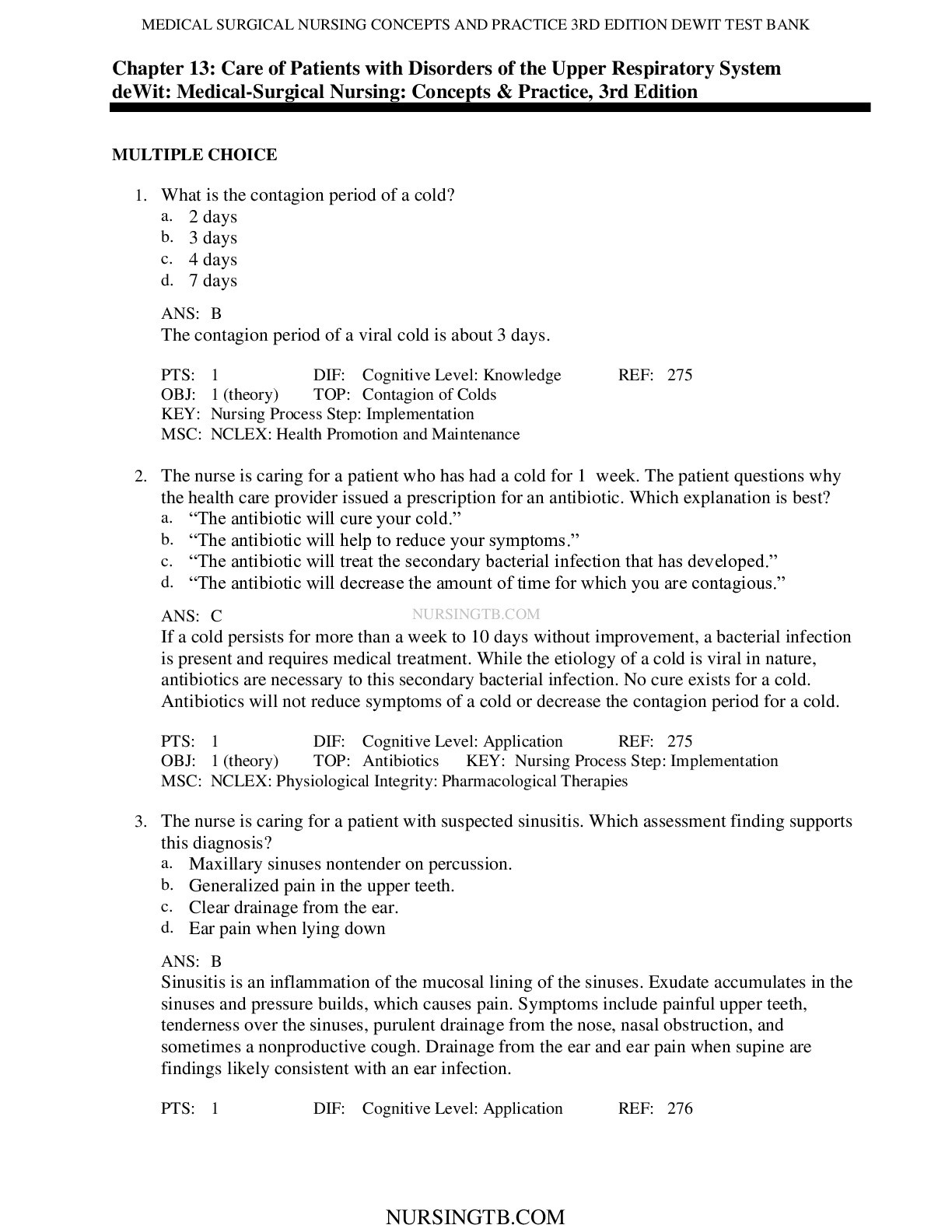All study resources > Chapter 13: Care of Patients with Disorders of the Upper Respiratory System deWit: Medical-Surgical Nursing: Concepts & Practice, 3rd Edition (Nursing)
Chapter 13: Care of Patients with Disorders of the Upper Respiratory System deWit: Medical-Surgical Nursing: Concepts & Practice, 3rd Edition
1. What is the contagion period of a cold?
a. 2 days
b. 3 days
c. 4 days
d. 7 days
2. The nurse is caring for a patient who has had a cold for 1 week. The patient questions why
the health care provider issued a prescription for an antibiotic. Which explanation is best?
a. “The antibiotic will cure your cold.”
b. “The antibiotic will help to reduce your symptoms.”
c. “The antib
...[Show More]
1. What is the contagion period of a cold?
a. 2 days
b. 3 days
c. 4 days
d. 7 days
2. The nurse is caring for a patient who has had a cold for 1 week. The patient questions why
the health care provider issued a prescription for an antibiotic. Which explanation is best?
a. “The antibiotic will cure your cold.”
b. “The antibiotic will help to reduce your symptoms.”
c. “The antibiotic will treat the secondary bacterial infection that has developed.”
d. “The antibiotic will decrease the amount of time for which you are contagious.”
3. The nurse is caring for a patient with suspected sinusitis. Which assessment finding supports
this diagnosis?
a. Maxillary sinuses nontender on percussion.
b. Generalized pain in the upper teeth.
c. Clear drainage from the ear.
d. Ear pain when lying down
4. The nurse is caring for a 20-year-old patient who recently underwent a tonsillectomy. The
patient is fully awake and clearing his throat frequently but denies pain. Which action is most
important for the nurse to take first?
a. Place the patient in a side-lying position.
b. Look in the patient’s mouth.
c. Offer the patient a grape popsicle.
d. Remove the straw from the patient’s tray.
5. The nurse is caring for a patient with sleep apnea. The patient complains that he is constantly
fatigued. Which response is most appropriate for the nurse to make?
a. “Patients with sleep apnea experience oxygen overloads, which lead to
drowsiness.”
b. “Patients with sleep apnea often wake frequently during the night.”
c. “Patients with mild sleep apnea benefit from a small amount of red wine right
before bed.”
d. “All patients have difficulty sleeping properly in the hospital.”
6. The nurse is caring for a patient during the immediate postoperative period following a
rhinoplasty. Which finding is most concerning to the nurse?
a. The patient complains of being cold and chilled.
b. The patient complains of nausea.
c. The nurse notices the patient is swallowing frequently.
d. The nurse notices drainage on the nasal drip pad.
7. The nurse is caring for a patient who has a tracheostomy with a one-way valve box. The nurse
explains to the CNA that this valve allows the patient to carry out which function?
a. Drinking
b. Eating
c. Coughing
d. Talking
8. Which statement is most important for the nurse to make when caring for an anxious patient
with a new tracheostomy?
a. “I have cared for patients who were able to have the tracheostomy reversed.”
b. “I will be efficient and give care quickly.”
c. “I will wait until your tracheostomy heals before teaching.”
d. “I understand that you might be apprehensive.”
[Show Less]
